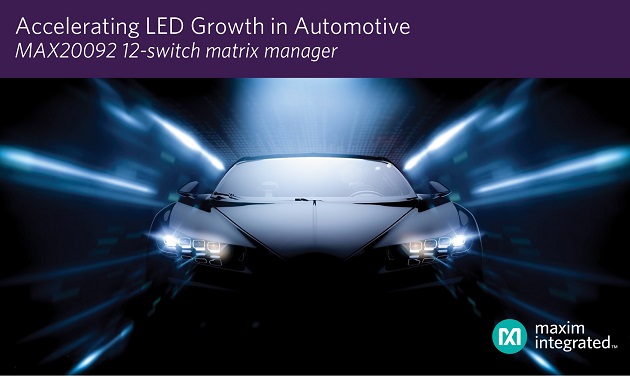Designers of high-performance automotive matrix lighting and adaptive driving beam light-emitting diode (LED) applications can now migrate to higher current devices while reducing solution size and improving flexibility with the MAX20092 12-switch matrix manager from Maxim Integrated Products. The IC minimizes thermal issues associated with LED matrix lighting applications by offering the industry’s lowest internal switch resistance (RDS_ON), which is 65 percent lower than the closest competitive solution.
Safety and brand differentiation are two of the leading factors driving greater adoption of LEDs in automotive front-lighting platforms, which are growing at 30 percent per year, according to Strategy Analytics, Inc. As part of their distinctive brand identities, OEMs are designing in advanced safety features such as glare-free high beams along with LED and matrix lighting. However, LED lighting designers are challenged with increasing power, thermal and design complexities.
The MAX20092 provides flexible current management for matrix and pixel lighting. Twelve integrated switches control LEDs in string voltages up to 56V, saving design time and reducing
complexity. Its integrated MOSFET on resistance (RDS_ON) of 70 mohm is the lowest in the industry – comfortably driving LED currents up to 1.5A. Maxim’s 12-switch LED matrix manager
is offered in a small 5mm x 5mm TQFN package. Additionally, Maxim today introduced MAX20096 and MAX20097 dual-channel, synchronous buck high-brightness LED controllers to work
with the MAX20092, helping designers improve transient response times in LED lighting. The MAX20096 and MAX20097 deliver ultra-fast transient response with near-fixed frequency with
Maxim’s proprietary average current mode control scheme, minimizing EMI and enabling a reliable, high-performing design.
Key Advantages of MAX20092
- Integration: Reduces bill of materials (BOM) costs while saving space. Manages one to two LEDs per switch with 12-bit pulse-width modulation (PWM) dimming. Provides built-in logarithmic fade-in/fade-out capability that simplifies LED programmability and reduces taxation on system bus lines.
- High Performance and Safety: Low RDS_ONof 70 mohm safely enables LED current of up to 1.5A. Features advanced fault protection and management for open, short and open-trace LED detection.
- Flexibility: Can parallel up to 27 MAX20092 devices without daisy-chaining to manage large LED pixel count of up to 324 LEDs; allows designers to configure1 string x 12 series switches, 2 strings x 6 series switches, and 4 strings x 3 series switches from each IC.
- Electromagnetic Interference (EMI) Mitigation: Slew-rate control reduces EMI and noise








